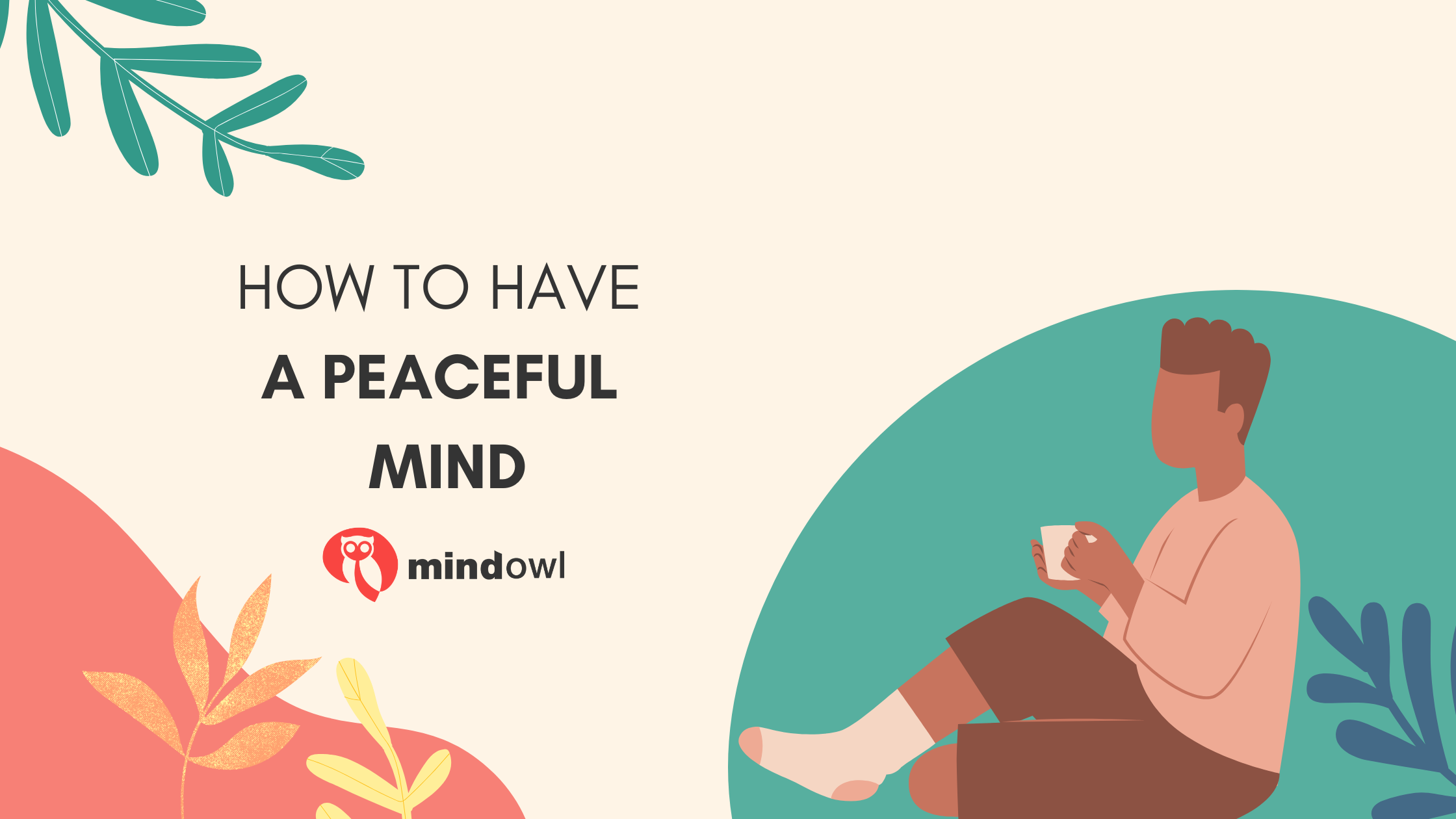In today’s world, stress is everywhere. Whether it comes from social media, work, school, relationships, or family, we are constantly bombarded with information and demands. This constant barrage of stimuli makes it difficult to focus on anything else. And when we don’t take time to relax and unwind, it often results in burnout and exhaustion.
We all know that stress isn’t good for us; it leads to anxiety and heart disease just to name a few health problems. But what if there was an easier way to live day to day?
It’s not necessary to be a Buddhist monk or practitioner in order to find peace within. You can attain tranquillity and serenity by re-framing your thoughts, focusing on the present moment, and living intentionally.
In fact, it’s often easier to achieve inner peace if you’re already happy. The key to happiness is by employing mindfulness through being mindful of what we focus on. If we spend our days thinking about all the things we don’t like about ourselves or our lives or our daily stresses, we’ll never feel peaceful. Our focus can be shifted away from those negative thoughts towards the positive aspects of life so that we can experience peace and happiness.
But in reality, we all know it is a daily struggle to be happy and content.

So, why is it so difficult to have a peaceful mindset?
We often have misconceptions about our own peace and happiness. Much of the time we are stuck on what psychologists call the “Hedonic treadmill” constantly debating “if-then…” problems with ourselves. “If I get promoted, then I’ll feel content”, “If I have a new partner, then I’ll feel at peace”, or “If I eat this chocolate, then I’ll feel happy”. But in reality, these things don’t change our happiness in the long term. Therefore, we miss out on the chance to enrich our lives in the present.
Our brains have developed to keep us alive and not to make us happy. Our innate tendency is to think and behave in ways that enhance our chances of survival and not those that improve our chances of long-term happiness. Modern psychology has demonstrated that people are more sensitive to negative experiences. Suppose we have nine positive experiences in 24 hours, but only one negative. We always dwell on that one negative experience. Our minds tend to be very sensitive because of this, explaining why much of what we think is negative.
We spend our time thinking about the past and the future. Because we are so worried about our safety, we live most of the time in the past or in the future. To avoid repeating the same mistakes in the future, we look back at the past. In order to anticipate and avoid potential problems, we look to the future. As a result, we miss the life that is happening right now.
We believe that our thoughts are facts. Since our thoughts are so frequent and intense, we believe that they are actually true. We often spend a great deal of time fighting with our thoughts, trying to change them, or worrying about how other people will perceive us. Have you ever felt bad about something you did, but if you asked another person, they would tell you it was no big deal? The thoughts we have can sometimes mislead our perception.
Peace of Mind in Daily Life
Okay. After all of that, take a deep breath in and release a long exhale. Can you feel that? The relief of tension and the clarity of mind? That’s because in the moments you let yourself truly breath, you focus truly on your breath. You aren’t focusing on the torrent of noises around you, or the millions of thoughts swimming in your mind. You focus on the sensation as you slowly inhale a lungful of air and the subsequent release. When you do that you engage your mind, and sympathetic nervous system, letting them know it’s time to slow down into a “rest and digest” manner. Then your mind sends a sequence of messages into your body, making you feel that sense of relief.
When you have this peace of mind you may be feeling:
- Comfortable
- At ease within yourself
- Self-compassion
- Free from daily worries
- Ready for the next challenge
But most often, we get caught up in the go-go-go of everyday life and forget to check in with ourselves. We go through our daily tasks; jumping up for work, rushing to eat breakfast, just making the train and so on. Once we are this distracted and stressed we tend to fall into what is called “thoracic” breathing, shallow or chest breathing. This shallow breathing in quick sequence doesn’t allow us to get enough oxygen which inevitably makes us feel more and more panicked throughout the day. Instead of letting the body periodically “rest and digest”, we are permanently in “fight and flight”, with low levels of oxygen, high carbon dioxide resulting in badly oxygenated blood. By the end of the day, you probably feel all the symptoms of heightened anxiety, panic attacks and anxiety attacks as a result, such as:
- Rapid heartbeat
- Tense muscles
- Unsteadiness, lightheadedness or dizziness.
- Dread
And our bodies over time, begin to breakdown after prolonged periods of anxiety and stress, resulting in:
- Exhaustion
- Disturbed sleep
- Anger
- Pain
- Attention problems
- Relationship problems
By being aware of and focusing on your breath throughout the day you can consciously bring your breathing pattern bath to a slow and even pattern. There are many breathing techniques that include deep breathing into your meditation practice, or just your every day that will improve your quality of life and mental health!
3 Breathing Exercises for Peace of Mind
To begin your journey of finding a peaceful mind, I would highly recommend finding a breathing practice that best suits you and your needs. Now it won’t take a couple of days to experience peace of mind but your meditative practice will be greatly enhanced by intentional breathing, relieving the negative impact of shallow breathing. Take a look at the next few techniques to see which one will best work for you!
Diaphragmatic Breathing Technique
In the middle of our body, between our chest and abdomen, is a dome-shaped muscle called the diaphragm. Our diaphragms tighten, flatten, and move downwards during inhalation, expanding our lungs. In the process of moving down, the diaphragm pushes the abdominal contents downward, causing the abdominal wall to separate. When we breathe out the diaphragm settles, the air is moved out of the lungs and the abdominal wall flattens. Also known as abdominal breathing, this deep breathing technique is proven by modern medicine to be an integral part of the “rest and digest” mode where the body recovers, like when you are asleep or digesting food.
Follow these 5 steps to try it out for yourself:
- Lay flat on the floor, or on your bed for more comfort. Make sure your shoulders, spine, are flat on the floor and comfortable. Close your eyes and relax your muscles as much as you can.
- Place one hand on your chest and the other on your stomach. With your hands, you will be able to monitor the rise and fall of your chest and stomach.
- Take a deep, slow breath in through your nose and feel the gradual rise of your belly, as your chest stays still.
- Release this breath through your mouth. With a relaxed jaw and pursed lips, exhale the breath until it is audible, an “ocean breath”.
- Repeat this cycle for a few minutes or the duration of your mindfulness meditation.
Buteyko Breathing Technique
Remember, the shallow breathing we commonly experience can lead to frightening symptoms like hyperventilating during a panic attack. When this occurs, the balance flips and we are experiencing an inundation of oxygen in the blood. Developed by doctor Konstantin Pavlovich Buteyko in the 1950s, the goal of the Buteyko Breathing technique is to retrain your breathing pattern to stop the body from naturally falling into this pattern.
Explore the effective technique with these 10 simple steps:
- Sit in a comfortable position.
- Take a soft breath in through the nose.
- Equally softly, release this breath in a mild exhale.
- After your lungs have released all the air they hold, pinch your nose bridge with your thumb and forefinger.
- Hold your breath.
- Keep your breath held for as long as is comfortable for you.
- When the natural urge to breathe rises, release your nose pinch and breathe out slowly.
- Return to your natural breathing pattern.
- Pause for 30-60 seconds until you repeat the exercise.
- Repeat the exercise until you feel comfortable, peaceful and at ease.
Alternate Nostril Breathing Technique
This final technique may be a little trickier to get used to and feel the benefits of, but I highly recommend trying it out with the following steps to see how it can help you find a peaceful mind:
- Using your right thumb, cover your right nostril.
- Take a gentle, deep breath in through your left nostril.
- Place your right index finger over your left nostril.
- Breathe out through your right nostril.
- Repeat this process; breathe into one nostril and out of the other, blocking the nostril you’re not using.
You can change how you feel by controlling your breathing. Observing people experiencing different emotions, researchers found that their breathing patterns varied based on the emotion. After that, the researchers gave other people breathing exercises to perform and asked them, “How do you feel?” The researchers found that the breathing exercises actually evoked the feelings.

How to Have a Calm Mind for Sleep
Other than our breathing, the most common complaint of those seeking a peaceful mind is that they find it hard to sleep and suffer insomnia. Bad and interrupted sleep can lead to mental health issues, but, there are many ways of using mindful awareness to enable ourselves to gain some peace of mind without having to rely on pharmaceuticals.
Accept the things you can’t control and change
Through accepting the things you can’t control around you and tolerating the things you can’t change, you will be able to use cognitive reframing to change your outlook on life. Try using phrases like:
- “I feel down right now, but I won’t always feel this way.”
- “I know what I’m going through right now is difficult, but I will succeed.”
Saying these phrases to yourself every night before you sleep, particularly during meditation, will aid you to feel peace of mind that allows you to sleep easier.
Practice forgiveness
When we hold on to emotions like rage, anger, disappointment and bitterness we end up using most of our “emotional energy” for negative reasons. More often than not, this will result in physical symptoms and mental health symptoms that can impact our everyday life. It is not unheard of for persistent anger management and anxiety problems to result in:
- Heart disease
- Stomach conditions
- Depression
- Anxiety
- Insomnia
A 2016 study conducted by psychologists called “Forgiveness, Stress, and Health: a 5-Week Dynamic Parallel Process Study” found that when the participants reported increased levels of forgiveness, their levels of stress which in turn lowered the number of mental health symptoms they experienced. When our symptoms like panic, anxiety and raised heartbeats are lessened we can get a good night’s rest!
Compassion for others.
Kindness and compassion for those around us, other than feeling amazing, is a proven way of maintaining a healthy, peaceful mind and in turn helps us live a longer, happier life. A study was conducted on those who had experienced trauma in their life. It is obvious to us all that those who had suffered these experiences experience a shorter lifespan. But not all these people did. Those who were active within the lives of their friends and family, giving a helping hand and being proactive members of their community. Service and compassion for the situation of others not only gives energy to the community around you but gives you energy!
It is not just a metaphorical benefit for you, when we perform acts of kindness for those around us, our heart rate is reduced. This is a direct outcome of our parasympathetic nervous system becoming activated by this interaction, which when done before sleep, will help you drift into slumber a bit earlier.
Developing self-compassion.
Now, when we have compassion for ourselves on the other hand – that may be slightly trickier! In order to truly have kindness and empathy for our own circumstances, we must be mindful of our emotions. In doing this, we are aware of our emotions when they are triggered, and recognise what has triggered them. It is best to remind ourselves we are only human when we are doing this. It is a human trait to make mistakes. When we do make mistakes, self-compassion is the ability to talk to yourself the way you would a distressed friend who just made a mistake.
This would be best done at bedtime as part of a pre-sleep routine to help lessen anxiety as research has proven we are calmer when we are empathetic towards ourselves.
Mindful Meditation Practice for a Peaceful Mind
This could seem to be a lot of advice, and you may be thinking how can you do this in practice? The best way to do this would be to begin to incorporate a body scan into your nightly mindfulness meditation. A 2020 study looking at the relationship between mindfulness-based body scan practice and insomnia relief found that young people who incorporated a body scan into their nightly routine experienced fewer symptoms of insomnia and disturbed sleep. This is the best type of meditation to gain a deeper sleep.
Body Scan:
- To begin the body scan, create a quiet, calm, space where you can become in tune with your emotions and your body.
- Lay flat with your back against the bed.
- Allow your shoulders, arms and legs to fall naturally, there’s no need to worry about how you are laying.
- Take a deep inhale, and let out a deep exhale. Let your body sink further into the bed, and notice the areas where your limbs are making contact with the bed’s surface.
- Continue to breathe deeply and equally, with each breath allowing your body to release more and more tension.
- Once you feel you are fully relaxed and calm, begin to bring awareness to your breath.
- Focus on the sensation being drawn into your lungs through your nostrils, or the sensation of your chest and stomach rising and falling in succession.
- Select one limb, like the tip of your little finger
- In your mind, now bring your attention to this one limb, and begin to note how it feels.
- Is it cold, warm or sore even?
- Continue to be aware of your breath, now as a continual flow of air throughout your body.
- With your focus on your limb, track your awareness up the rest of your body, from the tip of your finger to throughout your hand.
- Allow your awareness to then follow the path of your body up to your arm, to your shoulder and let it flow over to the other shoulder, down the armpit and towards your wrist.
- Follow the flow of your body, from each arm, down to your chest, over your stomach, down each leg and back up to your head.
- Follow this cycle as many times as you need, noting the sensations of each body part and limb as you go.
- If you get lost, don’t worry! Simply return to the last body part you remember focusing on.
- And especially don’t worry if you fall asleep.

I hope we have given you enough elements of meditation and meditation skills for you to explore in order to begin to find a more peaceful mind. If you want to explore more types of meditation with us, such as loving-kindness meditation or transcendental meditation read our blog post here to start your journey.
MindOwl Founder – My own struggles in life have led me to this path of understanding the human condition. I graduated with a bachelor’s degree in philosophy before completing a master’s degree in psychology at Regent’s University London. I then completed a postgraduate diploma in philosophical counselling before being trained in ACT (Acceptance and commitment therapy).
I’ve spent the last eight years studying the encounter of meditative practices with modern psychology.


3 thoughts on “How to have a peaceful mind”